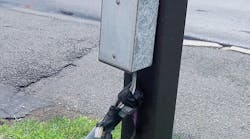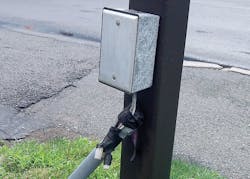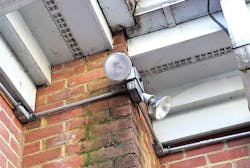How well do you know the Code? Think you can spot violations the original installer either ignored or couldn't identify? Here's your chance to moonlight as an electrical inspector and second-guess someone else's work from the safety of your living room or office. It's your turn to identify the violation.
Hint: Exposure disclosure
February Winners
Our three winners this month were: Brandon Tully, president of Skill Electric, LLC in Vincennes, Ind.; Mark Koester, an electrical estimator for RMF Nooter in Sylvania, Ohio; and Jean-Jacques Ahounou, P.E., an associate senior electrical engineer with Skidmore, Owings & Merrill LLP in Washington, D.C. Each of them correctly identified the Code violations shown in this outdoor luminaire installation.
In damp or wet locations, Sec. 314.15 requires boxes, conduit bodies, and fittings to be placed to prevent moisture from entering or accumulating inside. These boxes, conduit bodies, and fittings must also be listed for use in this wet location. Neither the “handi-box” nor the set-screw EMT connectors is designed for use in an outdoor wet location.
Section 314.29 requires the LB conduit bodies to be installed in a manner such that the wiring inside of them can be accessed without removing any part of the building or structure. Gaining access to the wires inside these conduit bodies would be impossible without smashing out some of the bricks or separating the raceways because the covers have been placed tight up against the brick walls. Lastly, Sec. 358.30(A) requires EMT to be securely fastened within 3 ft of each box or conduit body.






